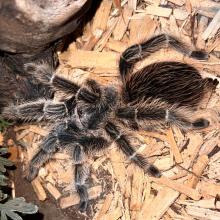Lasiodora difficilis

Conservation Status:
Not Evaluated
Range:
Brazil
Habitat:
Rainforests characterized by a wet tropical climate with little or no dry season and abundant rainfall
This species of tarantula is large, reaching sizes of up to 9 inches when fully grown. They possess prominent fangs that they use to capture prey. In addition, they have a defense mechanism of flicking fine hair-like spines that can cause irritation to potential predators.
Tarantulas, like all arthropods, have an exoskeleton. The exoskeleton is composed of polysaccharide fibers and reinforced with protein and mineral crystals in areas that require extra strength or flexibility. Due to the hard nature of their exoskeleton, tarantulas molt periodically to allow for growth. Young spiderlings may molt five or six times in their first year, while older tarantulas shed their exoskeleton about once a year.
These spiders typically inhabit holes or take shelter under rocks, displaying excellent camouflage in their environment.
The term "bird-eating" tarantula originated from an early 18th-century copper engraving depicting a tarantula consuming a hummingbird. However, in reality, these spiders rarely prey on birds. Their diet primarily consists of insects, frogs, and mice. The spider here eats insects.
